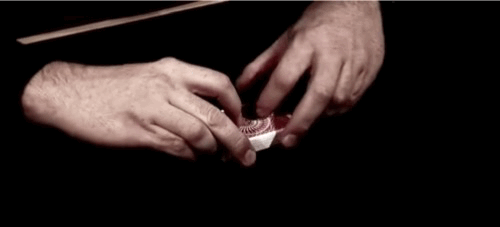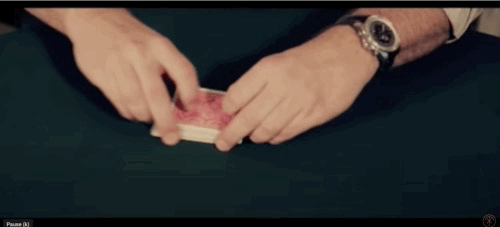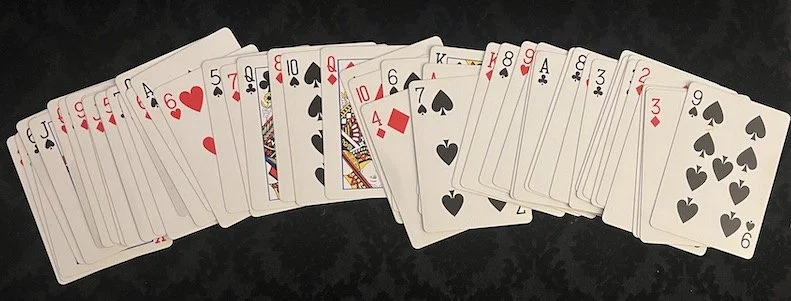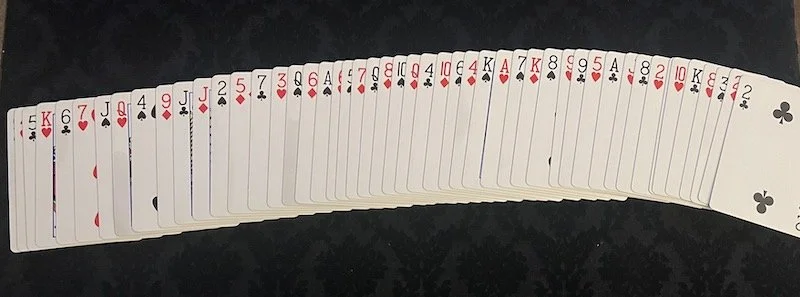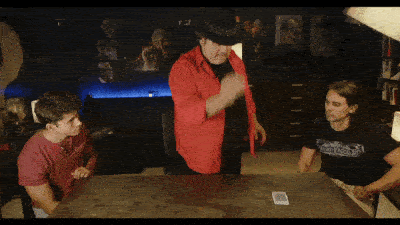Zarrow vs. Push-Through
/In Monday’s post, I ran a poll asking you which false-shuffle you thought was more convincing, a push-through shuffle or a Zarrow.
58% of you thought the Zarrow was more convincing.
42% of you said the the push-through was.
I asked that question in anticipation of this post which was inspired by another email regarding testing that I received last week from Turner B.
I’m thinking about perfecting a good false riffle shuffle. I’d love to have you test a Zarrow and a Push-Through shuffle to find out which one people find more convincing.—TB
Well, good news. We tested false shuffles many years ago. And these are results that I remember well enough to pass along to you.
We tested them in two different ways.
First, we showed people video of Jason England doing a push-through shuffle and a Zarrow shuffle.
We told them that one of the shuffles was a false shuffle and we asked them to pick which one they thought wasn’t a real shuffle. Nearly 80% of the respondents picked the Zarrow shuffle as being the fake one.
Now, you could say that was somewhat of an artificial test. And that’s true enough. They were focused on the shuffles and looking for a false shuffle. That certainly doesn’t suggest that a Zarrow appears false to 80% of people generally. This was just our way of putting one directly up against the other. “One of these is false. Which do you think it is?” Seemed like the most straightforward way of testing the two shuffles against each other in their purest form.
(By the way, the people who questioned the push-through shuffle almost always took issue with the “up the ladder” type of cutting people follow it up with. That was the part that seemed unusual to them. I think the shuffle is more convincing with just the strip-out and maybe one cut after that. Though I’m clearly in the minority about that.)
But, that’s not the end of the testing.
We tested a couple different tricks live with various groups of participants.
In the first trick, the magician shuffled the deck a few times. Then he turned his back and had someone turn over cards one at a time, and the magician was able to name each card even with his back turned.
That’s a trick that sort of screams false shuffle. And that’s what we wanted.
The second trick also relied on a false shuffle, but it was much more subtle than that. I don’t remember 100% what the trick was, and I asked a couple other people involved in the testing, and they weren’t sure either. But we’re all pretty certain it had something to do with finding a matching pair of cards. It doesn’t really matter what the effect was. All you need to know was that it was a trick that required a full deck stack and false shuffle, but that was a much less obvious method for lay people than in the previous trick where the cards were called off.
Four sets of people were part of this testing:
One group saw the “obvious” false shuffle trick with the Zarrow.
One group saw the “obvious” false shuffle trick with the Push-Through.
One group saw the subtle false shuffle trick with the Zarrow.
One group saw the subtle false shuffle trick with the Push-Through.
There were a few dozen people in each group. (Not at one time. We usually work in groups of 6 people at most. And this card trick would just have been one of several things we tested with them.)
As part of the testing, the participants were asked to postulate a method for the effects they saw. There was no statistical difference in the likelihood of someone suggesting a false-shuffle as part of the method regardless of if the trick they saw used the Zarrow or the Push-Through. Approximately 80% of respondents who saw the “obvious” false-shuffle trick mentioned a false-shuffle (or more generally something like, “the cards weren’t really mixed”) in their explanation. Whereas in the “subtle” trick, it was under 15%. To be clear, they weren’t saying, “I know for sure this is how it was done!” They were just suggesting a false shuffle or false mix as a possibility.
So, head-to-head, the push-through “won.” But in actual practice, either shuffle does the job. So if you’re more comfortable with one or the other there’s not a big difference.
Except…
In a future round of testing we were able to take the “obvious” false-shuffle trick and reduce the people who suggested a false-shuffle as part of the method down to about 20% (from 80%). And the way we did that is something you can only really do with one of these shuffles.
So how did remove the idea of a false-shuffle from a trick that where that should have been the “obvious” method?
Go back to Monday’s post that talks about Exposure as Convincer. In the lead-up to the calling of the cards, the performer said something along these lines: “In a moment I’m going to do something impossible with these cards. And the only explanation you’re going to have is that these cards aren’t really getting shuffled. That somehow this is a pretend shuffle. And the cards aren't actually mixing into each other. But you can see the cards are really getting shuffled, yes?” And he would pause one of his push-through shuffles after the initial riffle and pull the deck towards himself, showing both halves woven together. He’d then push the cards back and complete the push-through action. For a lot of laypeople—for whom the notion of pushing blocks of cards through each other is just way beyond their comprehension—this simple act “proved” the cards were really shuffled. And this is something that can’t be done as convincingly with a Zarrow.
I wouldn’t put this moment in every trick that uses a false shuffle. But I would include it in any trick where a false shuffle is likely to be the most obvious solution people suspect.
My Conclusion: If I was going to put my time into only one of these shuffles, I’d go with the push-through shuffle specifically because it allows for the moment I just mentioned—the moment that permits you to pause mid-shuffle to show it’s a “real shuffle.”
But in circumstances or effects where you wouldn’t want to put the focus on the legitimacy of the shuffle, I don’t think it matters much which you use.

